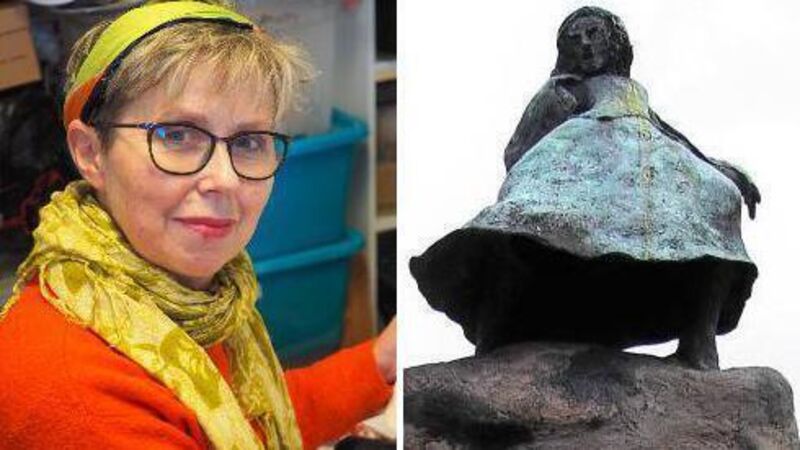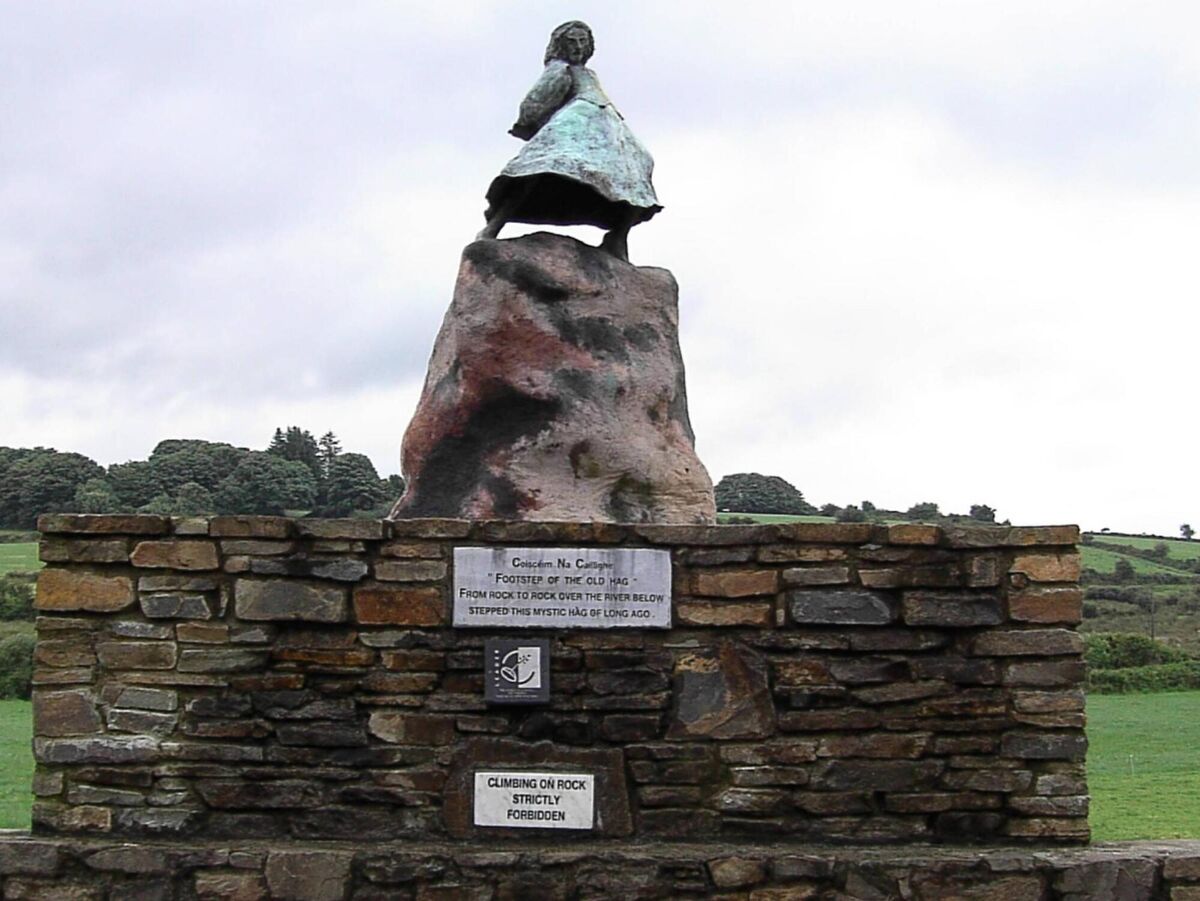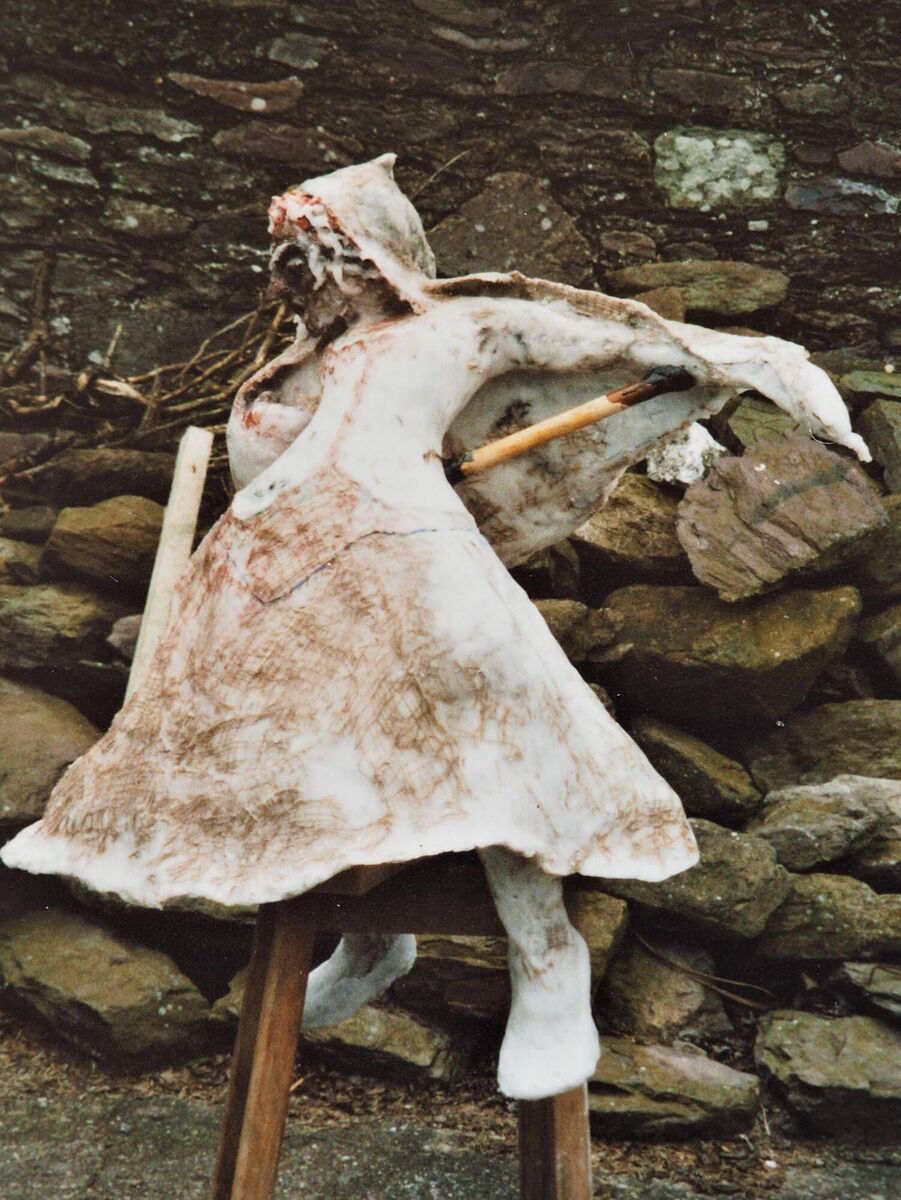Cork In 50 Artworks, No 37: Hag at Kiskeam, by Éilis Ní Fhaoláin

Éilis Ní Fhaoláin's and her Hag sculpture at Kiskeam, North Cork.
Éilis Ní Fhaoláin’s Hag sculpture in Kiskeam in North West Co Cork commemorates the mythological figure that lends the village its original name, Coiscéam na Caillí, the Hag’s Step.
The artwork was commissioned by Kiskeam Development Association in 2002. “I was put in touch with their committee through Ian McDonagh, the County Arts Officer,” says Ní Fhaoláin. “When we met up, they already had Leader funding in place, they had a site on the outskirts of the village, and they had in mind very much what they wanted for the sculpture.”
The committee gave her the local background on the Hag, or Cailleach. “There are different versions of the story,” she says. “The one I heard originally was that the Hag was being chased by the Fianna when she jumped off this particular rock and disappeared into the mist. But since then I’ve heard another version, that she fancied Fionn MacCumhail’s grandson Oscar, and was chasing him around the country. He tried to get away from her by jumping across a river. But he didn’t make it, he fell in, while she jumped past him onto the river bank. So, she was disgusted with him then, and had no interest in him anymore. Either way, there was definitely a jump involved.”

Ní Fhaoláin felt the sculpture should capture this dynamism. “I love physical movement, I’ve always done a lot of physical exercise myself, and the idea of the figure taking flight seemed important to me. I could be seen in my studio jumping off chairs to get the feel of it, I nearly gave myself whiplash doing that. But then I got the idea of the Hag’s cloak being caught in the wind, and that really helped with the design.”
Ní Fhaoláin made preparatory drawings at home in Cork, the city she first lived in when she moved down from Athy, Co Kildare, to study sculpture and filmmaking at the Crawford College of Art & Design. Further studies followed at Birmingham City University, where she completed an MA in Fine Art and worked as an artist for another three years. Her return to Cork coincided with her marriage to fellow artist Chris Samuels. Both got involved in the nascent Backwater Studios, at its original base on Watercourse Rd, and later when it occupied a large old building on Pine St.
In 1998, Backwater moved to its permanent home at Wandesford Quay, where Ní Fhaoláin began work on the maquette for the Hag. “I used wax and sackcloth, which helped with capturing the flow of the cloak. I made the head independently of the body; once I had the face, I could work down from the neck and shoulders.”

She had the work cast in bronze at Sarah O’Flaherty’s studio at Aghabullogue. “I had to break up the maquette and have it cast in sections that had then to be welded back together again. After that, I worked on it some more, to grind away the ridges left by the welding and to get more texture and detail back into it. It had a patination at the end as well, a coating of chemicals that gave it a sort of blue/green sheen. I’d already used some of the same processes for a Per Cent for Art Scheme project called the Glen Guardians I did at a school near where I live in Cork.”
The committee in Kiskeam had already erected a stonework plinth by the time Ní Fhaoláin visited again to determine how the Hag should be positioned. “But I felt there should be something else, something more organic looking, between that and the sculpture that would give it more height. So I made up this sort of concrete mush, a process that’s often used in boat building. I had buckets full of the stuff I worked with on site.”
Hoisting the Hag into place was, says Ní Fhaoláin, “a challenge", but it worked out fine on the day. "The committee were really helpful, and I had Sam with me as well. The whole project took about a year; the sculpture was commissioned in 2002, and installed in 2003. It’s great to see it’s still there, and that it’s become a landmark in Kiskeam.
“There was this whole discussion lately on Twitter, in relation to placenames, and someone posted pictures of the sculpture. There were different comments beneath the pictures, and someone remarked on how, when you’re driving past one day, the Hag seems to be flying off in one direction, and the next day, it can seem to be going in a different direction altogether. It was brilliant to read that after all these years; it brought me back to the original decisions I’d made about how the piece should be positioned.”


